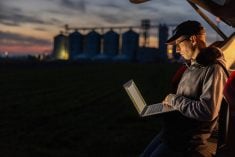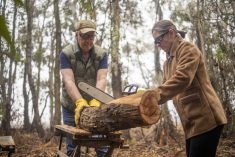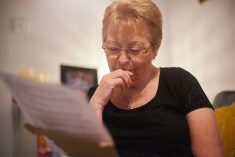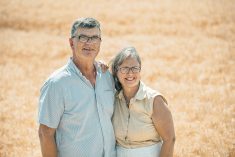In southern Manitoba, a farming couple we’ll call Bob and Suzy (not their real names) are, at their respective ages of 82 and 80, approaching full retirement. They have one son who farms and two daughters who have city jobs. The children are in their 40s. Bob and Suzy are contemplating posterity and are eager to make the conveyance of their wealth to their children fair from each child’s point of view.
Bob and Suzy approached Colin Sabourin, an experienced financial planner with Harbourfront Wealth Management in Winnipeg, to devise a retirement plan. The problem is not only to achieve equality and fairness in the estate plan, but ensure the parents have sufficient funds to support them in retirement. They already have diversified assets in $1.6 million of diversified stocks and mutual funds.
Bob and Suzy own 480 acres with an estimated present value of $2,880,000 and an adjusted cost base of $400,000. That leaves a taxable gain of $2,480,000. They figure they will need $80,000 per year before tax or $60,000 after tax, age credits, etc. That amount already comes from Old Age Security (OAS) at $7,707 each at 2022 rates, combined 2022 annual CPP payments totalling $21,000 and the $43,586 balance from their portfolio in taxable investments in stocks and mutual funds.
Read Also

Gentle treatments for pain in the neck
Heading toward year-end, people unknowingly tense up against the cold and busyness, causing neck pain that can often be treated with appropriate support and gentle mobility, athletic therapist Kathlyn Hossack says.
Their farm has some history. Twenty years ago, Bob and Suzy helped their farming son get started with a gift of 1,000 acres. The land had a value of $1,000 per acre, so the gift had a total value of $1 million. They had a $1.5-million life insurance policy for their non-farming children and planned to gift their remaining 480 acres to their farming son. But given the appreciation in land prices from $1,000 per acre to $6,000 now, they worry that their bequests will not be fair or even. The 1,000-acre gift from twenty years ago to the farming son has grown to $6 million today.
If Bob and Suzy passed away today, using the valuation of $6,000 per acre, the farming child would get $2,880,000 of land and the non-farming children would receive the remainder of assets and the life insurance. That would be a package worth $3,500,000 before taxes on $150,000 in Registered Retirement Income Funds and non-registered assets. The $3.5 million less $150,000 leaves $1,675,000 for each non-farming child and $2,880,000 for the farming child.
This appears to be a fair and equitable solution, Sabourin explains, for the farming child gets more but will have to work the land to get full value. The non-farming children get cash. In income terms, the farming child might earn $100 profit per acre per year, $48,000 per year. The non-farming children might get five per cent or $83,750 per year from their bequests with little sweat. The exact number depends on assumptions, of course.
If we used the 1,000-acre gift two decades ago, there is a question of the present value of the gift. The farming child would then have $3.88 million and the non-farming children $1.675 million each. Updated to today’s prices, the farming child has property worth $8,880,000 and each non-farming child $1,675,000 at cost. The issue is how to value the farmland.
It is also a matter of equity and fairness. Inflation raised the value of the farmland and the farming son has had a hand in maintaining and increasing the value. However, the non-farming children, had they received $1 million in cash two decades ago, might have made the money grow. At a five per cent growth rate for two decades their money would have risen to $2,653,300 today.
What to do? We can differ on rates of growth on assets, but the farming son did get $1 million of land 20 years ago. That’s irrefutable. So, Bob and Suzy could have the farming son buy their remaining 480 acres with the proceeds to the non-farming children.
Alternatively, the farming son could buy a life insurance policy on his parents instead of paying $2,880,000 for the farmland. The life insurance policy would be cheaper. The premiums on $2,880,000 would cost the farming child $1,875,523 over the next decade. That could save about $1.1 million compared with paying $2,880,000. The policy would pay the non-farming children while the farming son would have land of comparable value. It seems fair.
If the farming child cannot afford to buy the land or pay for a life insurance policy, Bob and Suzy could gift a part of their 480 acres to their two non-farming children. That would achieve a good level of fairness. They might facilitate this by moving their land into a corporation and making the parents and children shareholders. The farming child would rent the land from the corporation. The rental income would then be distributed to the shareholders.
The parents would create a shareholders’ agreement that would specify how and when shares of the corporation could be sold. That will protect the farming child if his siblings sell their shares as soon as they receive them. Then, upon the parents’ deaths, their corporate shares would be split among the three children. This is not optimal from the perspective of the farming child; however, it is a way to leave more to the non-farming children, Sabourin explains.
These alternatives are solutions to the fairness problem. Two decades of time and inflation have created a fairness issue, but the alternatives of packaging and protecting value create a fair system of generational transfer, Sabourin explains. The parents are already financially secure in terms of money they need for retirement. This plan, aiming for fairness, should ensure all family matters are resolved, Sabourin explains.
There is some expense for accounting, valuation and legal matters, but achieving fairness has a value, even if intangible, Sabourin concludes. Moreover, this plan and partition of value presents all three children with a fair way of dividing their parents’ life work. The past is prologue. The trick is to avoid errors that no one can forget.















